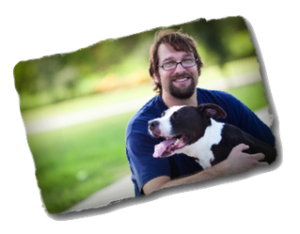I’ve been hanging out on a forum recently where I’ve been speaking with dog training expert, Chad Mackin, of Pack To Basics and DePaw University Canine Campus Inc. in Illinois. I noticed that Chad kept using a term that I hadn’t heard in the dog industry and I wanted to get his take on it.
He kept talking about ‘adrenalized dogs’, ‘dogs in an adrenalized state’, and other terms relating to adrenaline.
Now, I know what adrenaline is, but I hadn’t thought of it’s relation to dog training and dog behavior. I decided to invite him onto the podcast and he was kind enough to lend me a half hour of his life to explain these terms and how they can benefit the every-day dog owner.
Dog Training- What Will You Learn In This Podcast?
- Learn how you can tell from your dog’s eyes if he is in an adrenalized state and what that means.
- Learn to decipher body positions in order to understand what condition your dog is currently in.
- Find out two KEY DOG TRAINING commands that are easy to do but can help just about any dog lead a happier life.
- Understand the definition of what an ‘adrenalized dog’ is and if your dog falls into that category.
- Uncover techniques that you can use that can actually teach your dog to self-regulate whether you are home or not. (Dealing with destruction or other inappropriate behaviors while you are gone? You NEED to listen to this.)
- Discover what is at the root cause of your dog being happy or not and how you can help your pet achieve happiness and satisfaction every day.
- You’ll learn the right way and the wrong way to properly socialize a dog (he talks about play groups, dog parks, day cares and more. Hint: some of these are great and others can do serious damage to a dog’s mental state).
Overall, this is just under a half hour of a podcast jam-packed with information and tips for dog training, fixing dog destruction, fixing anti-social behaviors, aggression, and more.
If you’re dealing with any of these issues I recommend you listen with a pen and paper because you will definitely walk away with a few critical changes that you can start making today in order to see more success with your dog tomorrow.
Dog Training- Listen to the Podcast Below
Press play below to listen in. Enjoy!









8 Responses to “Dog Training Interview With Renowned Trainer, Chad Mackin”
On the topic of heeling. There is always the time when your dog is on a command and when their not. You have to let them know when they are and when their not. You tell them to do something and then you release them from the command. A lot of people don’t do that. Give them the OK ! your free . When you tell a dog to heel, it’s a place where they should be, right next to you. When you go out for a walk your dog is not on a command all the time. Yes, start them on a heel, make them be where there supposed to be but after a while release them, not off the leash, but from that heel, which is right next to you. Let them check out whats going on to look around or walk in front of you, not behind. Encourage them to see whats going on. Then give them the command Heel. They should then come back to where their supposed to be . Going for a walk is fun but so is training.
Agree with Bill here in this regard..and in conjugation the ‘release’ is a reward..a reward for walking nice..I always incorporate the ‘release’ as reward with ‘walk’, ‘heel’ training. Give me five good steps, release..give me 12 good steps, release.
Then you can naturally introduce a ‘here’ or ‘come’ instruct as on a long lead with larger distance latitude or otherwise back to ‘walk’.
Your walking exercises now incorporate ‘walk’, ‘away’, and back to ‘walk’ or ‘here’ then ‘walk’. The ‘here’ or ‘come’ instruct in this scenario still offers reward centric as a good return can fluidly continue into a walk or movement forward. You can structure anyway you like or no structure at all..mix it up. I believe it is easier to facilitate good walking if the dog appreciates that at some point to all this walking there will be times to smell and investigate..start with frequency in the change ups at first and then ration them out with more walking in between releases.
Can you say “good down ” during the down stay?????
I don’t know Chad’s take but my personal training style is that, yes, I can praise the dog during a long down stay. I don’t overpraise, though, as the idea behind a long down stay is to teach the dog to cope with the skill of ‘just being’. If I say TOO much and interact too much during a long stay then I can defeat the purpose by always bringing the dog out of calmness potentially. So for me the idea is to praise a bit at the beginning and perhaps a bit during but not a lot.
I have been working with K9 Lifeline and Wasatch Canine Camp into furthering my education in the dog training world. Chad Mackin was/is (he is stepping down at the end of this year) the President of the IACP (International Association of Canine Professionals). He is a great inspiration to me, and I’m happy I am a member of the IACP. I am constantly impressed with everything I have learned from him, as well as the IACP. Learning to teach a dog to not be in the adrenalized state, was one of the most valuable things I have learned so far in all of my training.
I have also really been impressed with the dogmanship seminars in the past, and I have learned so much about how dog parks ARE NOT a good idea. I am really impressed with Chad, and he is incredibly helpful in my journey of dog training.
Great podcast.
Hi I was just wondering I’m training my dogs at home. And I have got all the basic down. But now I would like teach like roll over. Fetch, pick up. Etc. Can you please help me
No one really understands why some dogs experience these panic attacks and others show no signs of anxiety during the same circumstances.
I don’t understand the comment. There are literally thousands of professionals and amateurs around the world who understand why some dogs get panic attacks and others don’t.
Did I understand your comment correctly? Apologies if I didn’t.